Central Kalimantan is a province in Indonesia located on the island of Borneo. It is home to a diverse range of bird species and is an important destination for birdwatchers and ornithologists.
The region is known for its rich biodiversity and is home to a variety of species found nowhere else in the world.
Some of the most notable birds found in Central Kalimantan include the endangered White-fronted Falcon, the Bornean Bristlehead, and the endemic species of the Black-bellied Malkoha.
The province also boasts a wide variety of migratory bird species, with an amazing array of shorebirds, waterfowl, and raptors all making the journey to Central Kalimantan for the summer.
With its spectacular scenery, diverse birdlife, and remote wilderness, Central Kalimantan is a paradise for birders of all levels.
1. Yellow-Vented Bulbul
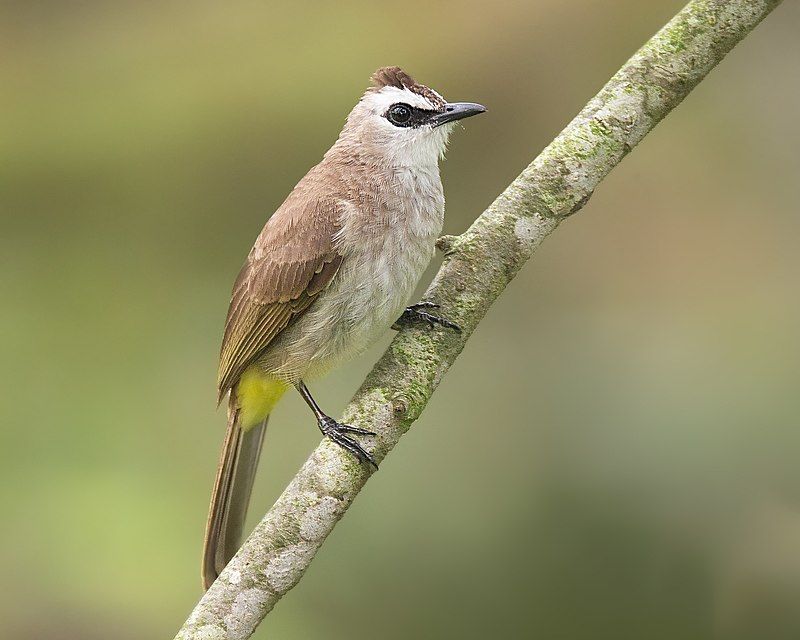
The yellow-vented bulbul is a species of passerine bird belonging to the bulbul family. It is a resident breeder in southeastern Asia, ranging from Indochina to the Philippines.
It is a highly adaptable species that can be found in a variety of open habitats, such as grasslands, scrublands, and other lightly-wooded areas. However, it is not found in deep forest areas. This species is quite common and can often be found in urban parks and gardens.
It has a yellowish underside and chest and is easily identified by its bright yellow vent. It is a medium-sized bird with a pointed crest and a short tail. Its diet consists mainly of insects and fruit.
The yellow-vented bulbul is an important species in its native range, playing an important role in maintaining the balance of the local ecosystem.
| Kingdom | Animalia |
| Phylum | Chordata |
| Class | Aves |
| Order | Passeriformes |
| Family | Pycnonotidae |
| Genus | Pycnonotus |
| Species | P. goiavier |
2. Bornean Ground Cuckoo
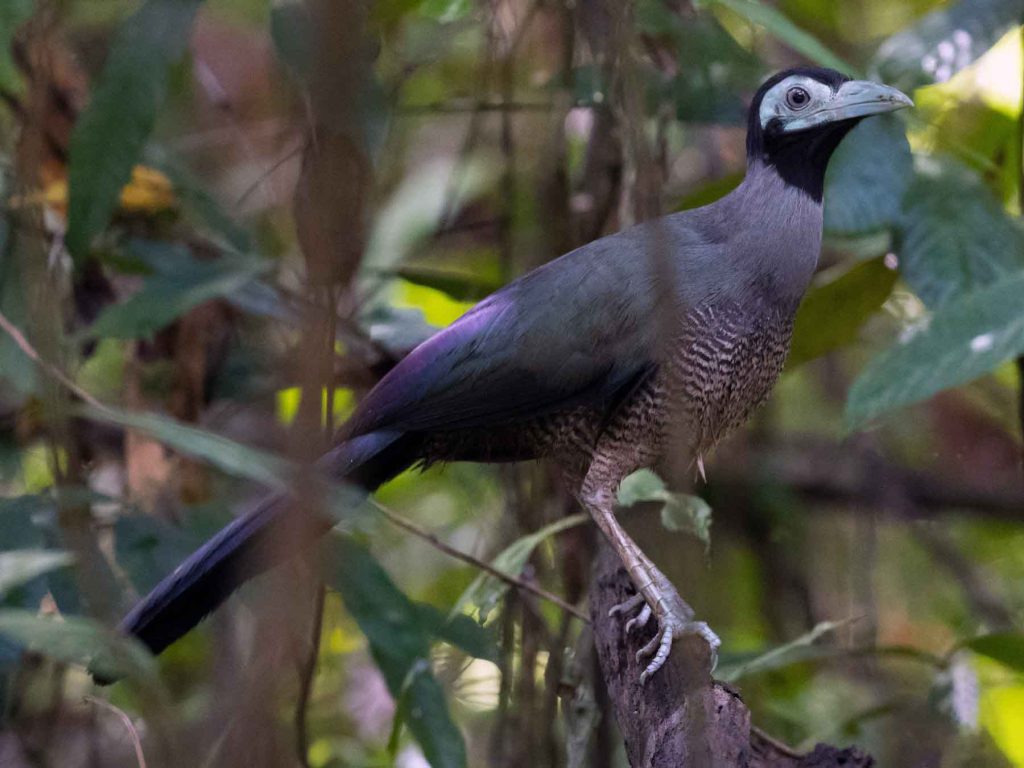
Source: ebird.org
The Bornean ground cuckoo is a unique species belonging to the Cuculidae family, and is native to the island of Borneo. It lives in Brunei, Malaysia, and Indonesia, and is only found in humid forest habitats.
Unfortunately, the Bornean ground cuckoo is facing a serious threat due to the destruction of its habitat. As deforestation, logging, and other human activities continue to take their toll, these birds are losing their homes and becoming increasingly vulnerable to extinction.
Conservation efforts are necessary in order to ensure that the Bornean ground cuckoo can continue to live in its natural habitat and avoid the threat of extinction.
If we are to protect this species, it is essential that we put an end to the destruction of its habitat, and create protected areas where it can thrive.
| Kingdom | Animalia |
| Phylum | Chordata |
| Class | Aves |
| Order | Cuculiformes |
| Family | Cuculidae |
| Genus | Carpococcyx |
| Species | C. radiceus |
3. Crimson Sunbird
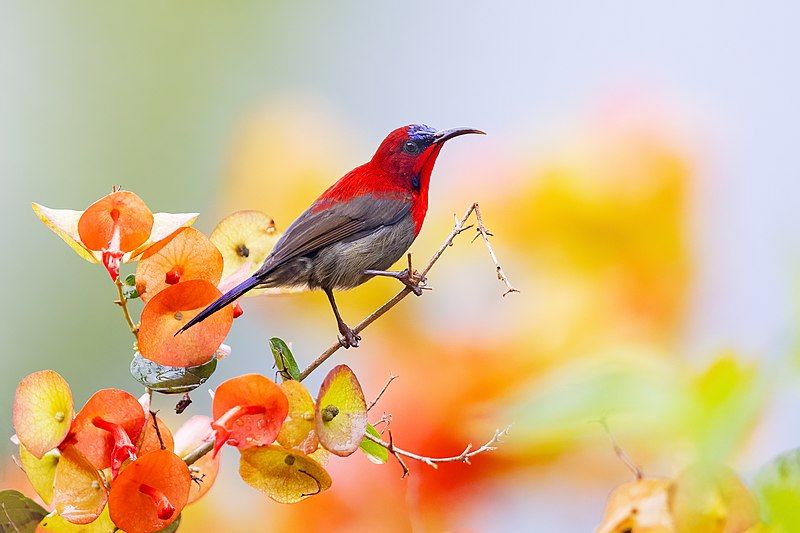
The crimson sunbird is a species of small bird in the sunbird family. These birds have a vibrant red color and they feed mainly on nectar. They also eat insects, especially when they are looking after their young.
They are able to fly at a very fast speed and in a straight direction due to their short wings. Most species of crimson sunbirds have the ability to hover like a hummingbird while feeding on nectar. However, they usually choose to perch while they eat.
These birds are found mainly in areas with plenty of flowers and shrubs, as they rely heavily on the nectar of these plants for their food. They are a popular sight for bird watchers and are often seen in gardens, parks, and other areas with abundant vegetation.
| Kingdom | Animalia |
| Phylum | Chordata |
| Class | Aves |
| Order | Passeriformes |
| Family | Nectariniidae |
| Genus | Aethopyga |
| Species | A. siparaja |
4. Crimson-Headed Partridge
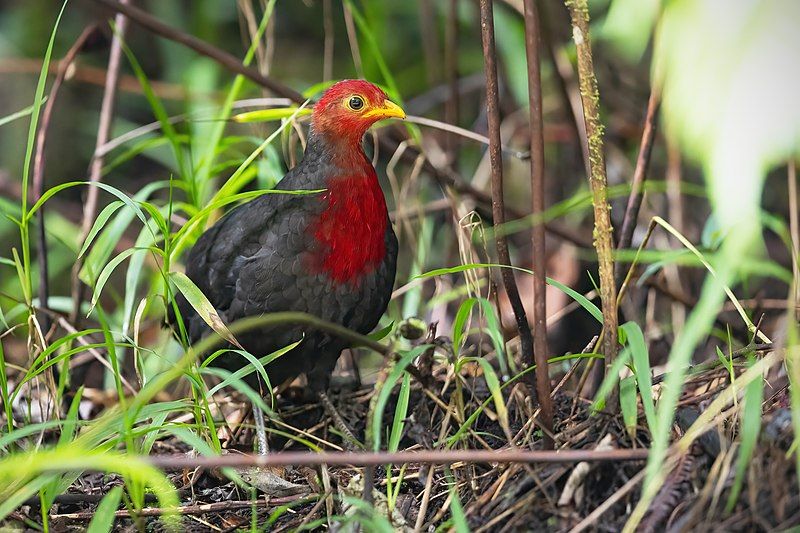
The crimson-headed partridge is a unique species of bird that belongs to the family Phasianidae, which includes pheasants, partridges, and francolins.
It was first described by British ornithologist Richard Bowdler Sharpe in 1879, and is the only species in its genus, Haematortyx.
The crimson-headed partridge is known for its striking plumage, which is usually a vibrant red or orange along the head and neck, and a grey or brown back and tail. The wings are typically a darker shade of brown or black.
These birds are usually found in grasslands and open woodlands in parts of southeastern Asia, such as Cambodia, Laos, and Vietnam. They are ground-dwelling birds that feed mainly on insects, plants, and seeds.
The crimson-headed partridge is considered to be near threatened due to habitat destruction and overhunting. They are also vulnerable to predation by feral cats, dogs, and other small mammals.
Conservation efforts are being made to protect and preserve this species, and help it recover its population.
| Kingdom | Animalia |
| Phylum | Chordata |
| Class | Aves |
| Order | Galliformes |
| Family | Phasianidae |
| Genus | Haematortyx |
| Species | H. sanguiniceps |
5. Greater Coucal
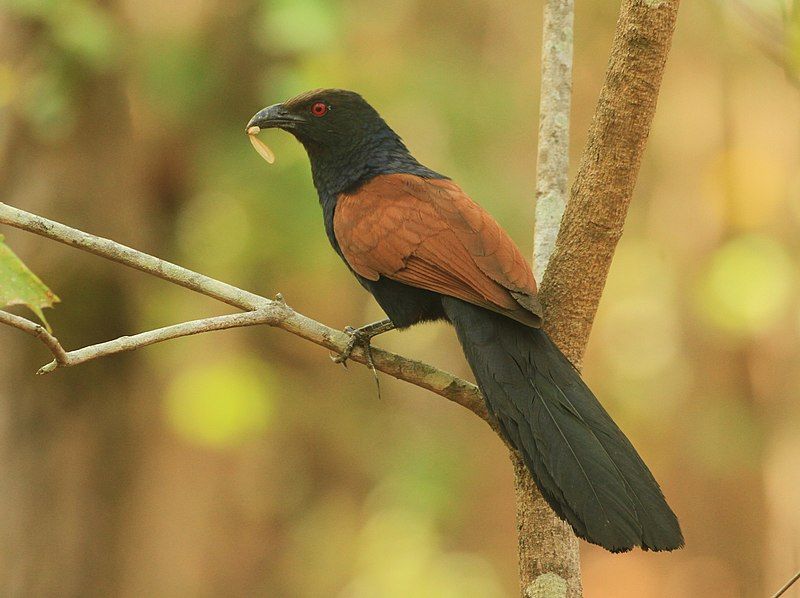
The greater coucal, also known as the crow pheasant, is a large bird from the Cuculiformes order. It is a common resident of the Indian Subcontinent and Southeast Asia and is divided into several subspecies.
These subspecies are often seen as distinct species by some, as they have evolved to develop different characteristics. The greater coucal is known for being a non-parasitic bird, meaning it does not depend on other species for its survival.
It is usually found in open areas, such as fields, gardens, and wetlands, and is a solitary creature. Its diet consists mainly of insects, small reptiles, and fruit, although it can sometimes eat small mammals and amphibians.
It is a vocal species, with a distinct call that is often heard in the early morning and late evening. The greater coucal is an important species in its habitat, as it helps to control insect and rodent populations.
| Kingdom | Animalia |
| Phylum | Chordata |
| Class | Aves |
| Order | Cuculiformes |
| Family | Cuculidae |
| Genus | Centropus |
| Species | C. sinensis |
6. Dulit Frogmouth
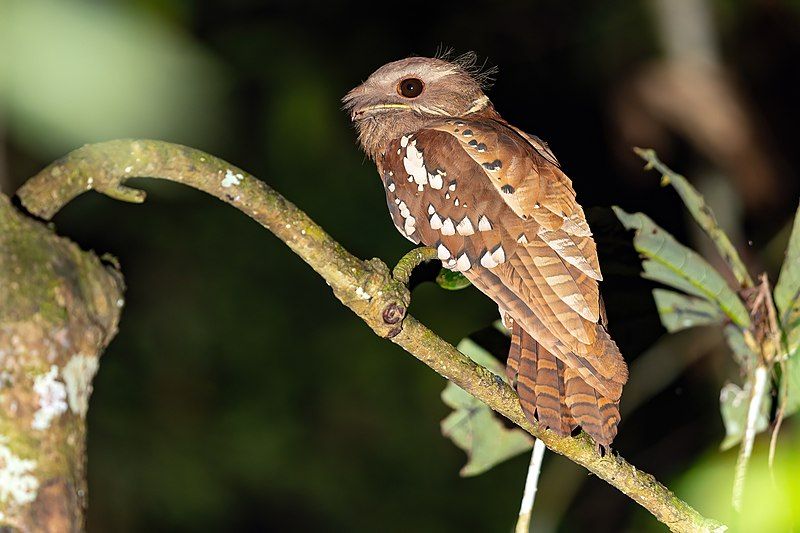
The Dulit frogmouth is a species of bird that is part of the frogmouth family, Podargidae. It is found mainly in the mountain forests of northern and central Borneo, meaning that it is endemic to this area.
This species is monotypic, meaning that it is the only species found within its family. This species is relatively unknown compared to other species of birds and its distribution is patchy, meaning that it is found in some areas but not others.
It is important to conserve this species as it is endemic to Borneo and its population is small. Conservation efforts should focus on protecting their habitat and increasing awareness of the species.
| Kingdom | Animalia |
| Phylum | Chordata |
| Class | Aves |
| Clade | Strisores |
| Order | Podargiformes |
| Family | Podargidae |
| Genus | Batrachostomus |
| Species | B. harterti |
7. Crested Fireback
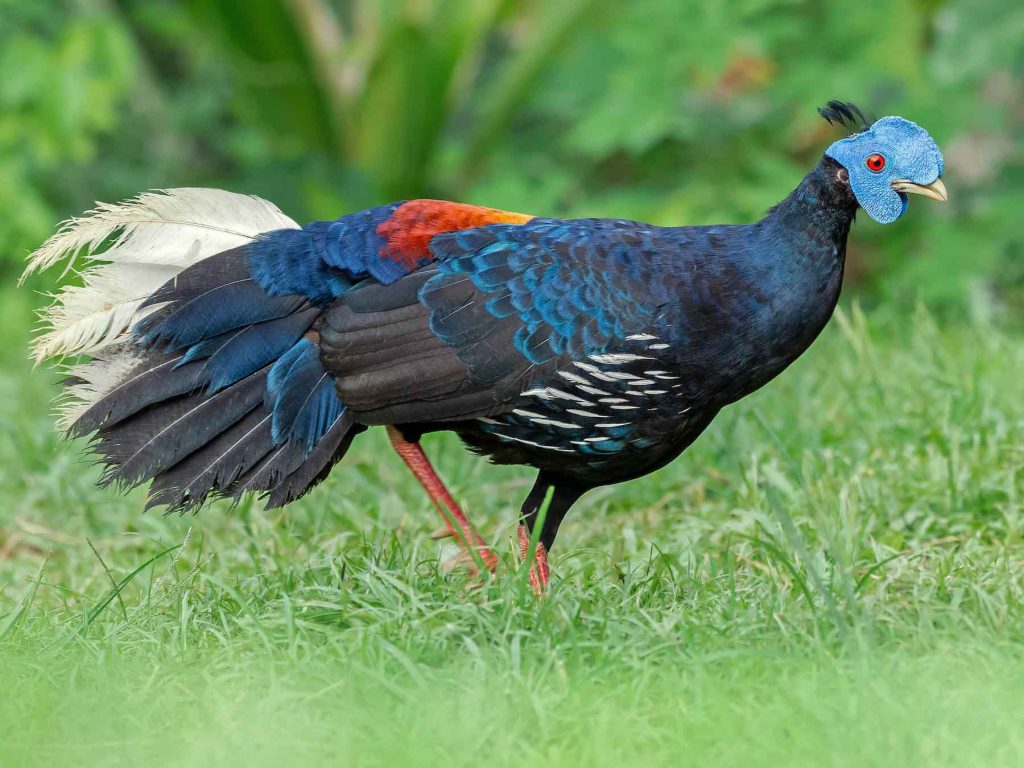
Source: ebird.org
The Bornean crested fireback is a medium-sized bird that is native to the forests of Borneo and the Bangka Belitung Islands. It is the type species of its genus, Lophura.
Up until 2023, the Bornean crested fireback was simply referred to as the crested fireback, as the Malayan crested fireback was lumped in with this species.
However, in 2023, the two species were split into separate species, with the Bornean crested fireback taking its current name. This split was due to the differences in plumage and size between the two species.
The Bornean crested fireback has been found to be larger than the Malayan crested fireback, and its plumage is a darker shade of brown. Both species are part of the same genus, however, which is why they were originally lumped together.
| Kingdom | Animalia |
| Phylum | Chordata |
| Class | Aves |
| Order | Galliformes |
| Family | Phasianidae |
| Genus | Lophura |
| Species | L. ignita |
8. Green Imperial Pigeon
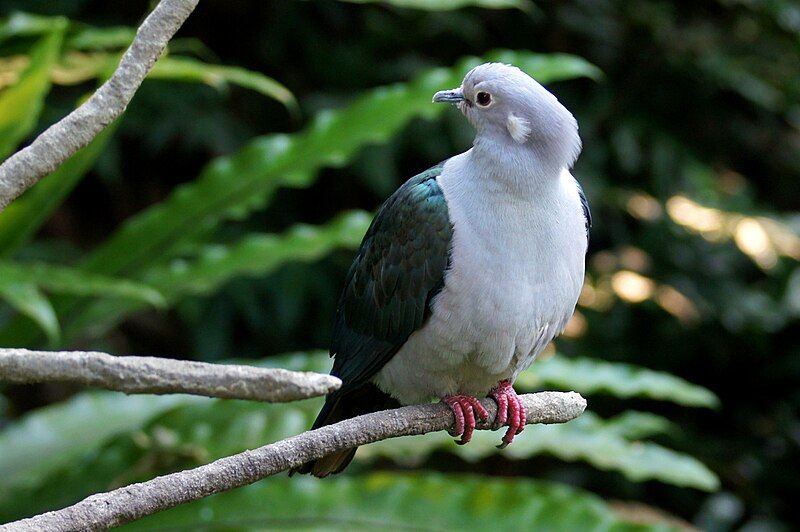
The green imperial pigeon is a large and impressive species of forest pigeon. It is found in an expansive range that stretches from Nepal, southern India, and Sri Lanka in the west all the way to southern China, Indonesia, and the Philippines in the east.
This makes it one of the most widespread species of its kind, and it can be found in a variety of habitats from lowland forests to mountain slopes and even in urban areas. Its size and coloring make it quite noticeable in its environment, and its diet consists mainly of fruits.
This species of pigeon is also known for its beautiful call, which can be heard in the morning and evening. This unique species of bird is important to the local ecosystem, and conservation efforts are being made to ensure its continued survival.
| Kingdom | Animalia |
| Phylum | Chordata |
| Class | Aves |
| Order | Columbiformes |
| Family | Columbidae |
| Genus | Ducula |
| Species | D. aenea |
9. Bornean Peacock-Pheasant
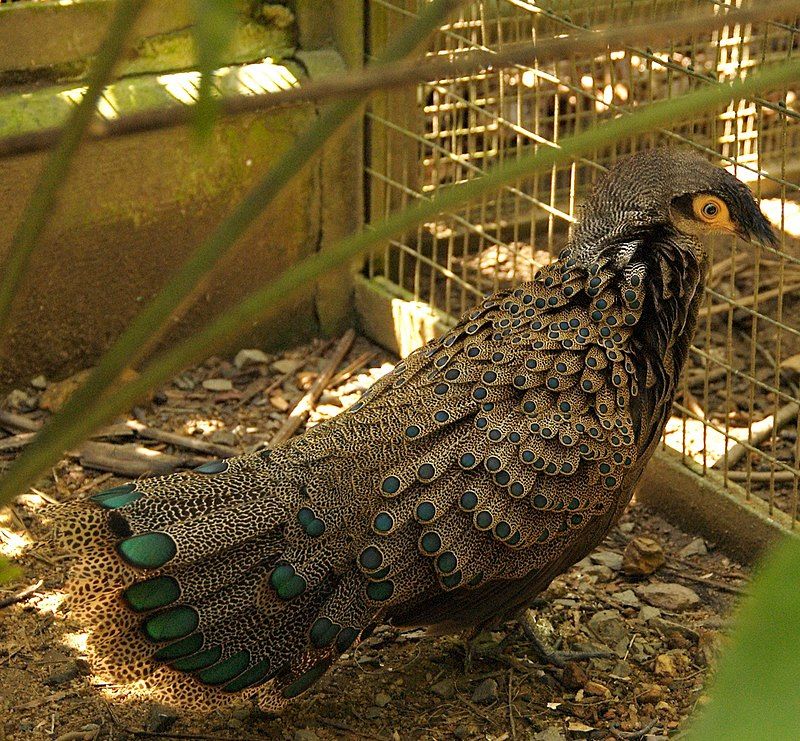
The Bornean peacock-pheasant is a unique and remarkable species of bird. It is a medium-sized pheasant that is found only on the island of Borneo in Southeast Asia. This species is considered to be the rarest and least known of all peacock pheasants.
It is a shy and elusive bird that is rarely seen in its natural habitat of lowland forests. The Bornean peacock-pheasant is easily identified by its unique plumage, which consists of black and white feathers with striking metallic blue and purple accents.
The male of the species is particularly showy and can be seen displaying its tail feathers in courtship rituals. The female is more plain in coloring, but no less beautiful. Due to its rarity and secretive nature, the Bornean peacock-pheasant has remained largely unstudied.
As a result, not much is known about its behavior or the threats to its survival. The destruction of its lowland forest habitat due to logging and other human activities is the biggest threat to its continued existence.
The Bornean peacock-pheasant is a species with a unique history and fascinating beauty. It deserves to be protected and studied in order to ensure its survival for generations to come.
| Kingdom | Animalia |
| Phylum | Chordata |
| Class | Aves |
| Order | Galliformes |
| Family | Phasianidae |
| Genus | Polyplectron |
| Species | P. schleiermacheri |
10. Pink-Necked Green Pigeon
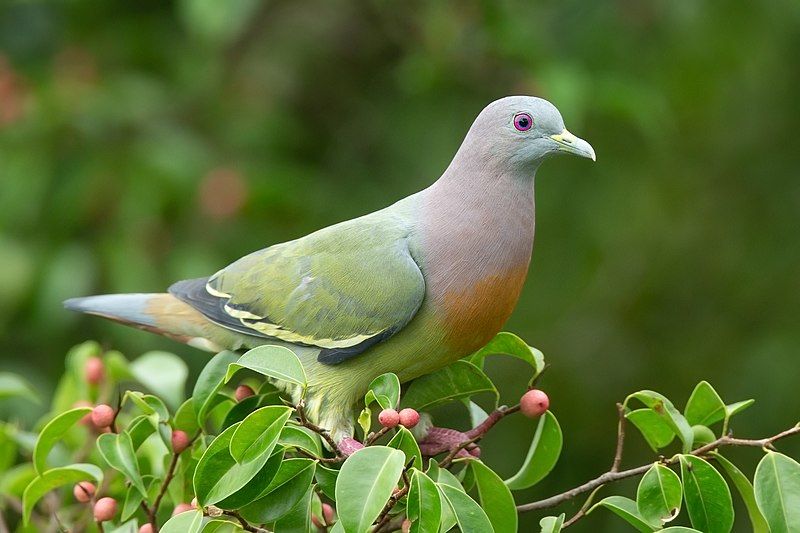
The pink-necked green pigeon is a unique species of bird belonging to the family Columbidae, which is made up of pigeons and doves.
It is a widely distributed species found in Southeast Asia, ranging from Myanmar and Vietnam in the north, all the way south to the major islands of Indonesia and the Philippines.
This species of bird is typically found in tropical and subtropical forests, typically in the lower and middle levels of the canopy. It has a characteristic pink neck, with a glossy green plumage covering its body.
They feed primarily on fruit, nuts, and seeds, and are generally seen in pairs or small flocks. They are known to be quite vocal, with a variety of cooing, cackling, and croaking calls.
Overall, the pink-necked green pigeon is an interesting and unique species of bird that is typically seen in tropical and subtropical forests of Southeast Asia.
| Kingdom | Animalia |
| Phylum | Chordata |
| Class | Aves |
| Order | Columbiformes |
| Family | Columbidae |
| Genus | Treron |
| Species | T. vernans |
11. Stork-Billed Kingfisher
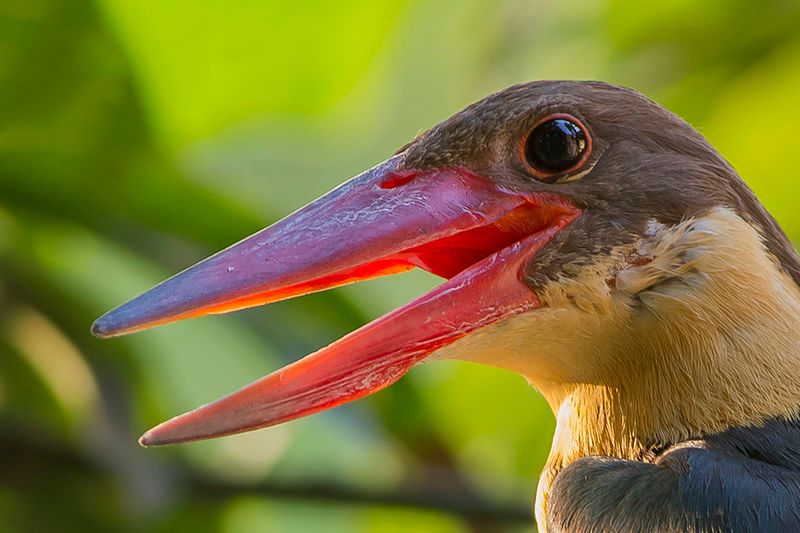
The Stork-billed Kingfisher is a species of tree kingfisher, and is found in a wide range across the tropical Indian subcontinent and Southeast Asia, from India to Indonesia.
This species of kingfisher is a resident throughout its range, which means it does not migrate and remains in the same location year-round. The Stork-billed Kingfisher is quite large in size, with an approximate length of 35 cm.
It is easily distinguishable by its yellow chest and bright blue wings. Its beak is quite long and curved, resembling a stork’s beak, which is where it gets its name. This beak is perfectly designed for catching fish from lakes and rivers, which is their primary food source.
In addition to fish, these birds will also feed on lizards, frogs, insects, and even small mammals. The Stork-billed Kingfisher is an important member of the ecosystem, as it helps to control the population of some species of smaller animals.
It is also a beautiful bird to observe in its natural habitat, with its bright colors and impressive size.
| Kingdom | Animalia |
| Phylum | Chordata |
| Class | Aves |
| Order | Coraciiformes |
| Family | Alcedinidae |
| Genus | Pelargopsis |
| Species | P. capensis |
12. Black Oriole
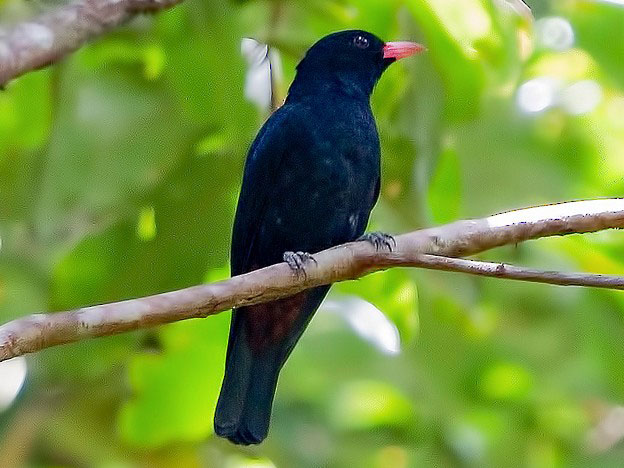
Source: ebird.org
The black oriole is one of the species of bird that belongs to the family Oriolidae. It is native to the island of Borneo, and its range is limited to Sarawak.
The black oriole is one of the least known orioles, and it is part of a clade that includes the black-and-crimson, maroon, and silver orioles. This clade is known for its red and black feathers.
This species of bird is found in tropical and subtropical forests, as well as mangrove forests. The black oriole feeds mostly on insects, but it will also eat fruit and nectar from flowers. It is a solitary bird that lives in flocks of up to four individuals.
Its breeding season is from April to July, and its nest is usually found in the canopy of a tree. The black oriole has a beautiful song that is composed of long melodic trills and whistles. It is a highly vocal species that is often heard before it is seen.
Unfortunately, this species is threatened due to deforestation and habitat loss. Conservation efforts are needed to ensure the survival of this species.
| Kingdom | Animalia |
| Phylum | Chordata |
| Class | Aves |
| Order | Passeriformes |
| Family | Oriolidae |
| Genus | Oriolus |
| Species | O. hosii |
13. Golden-Naped Barbet
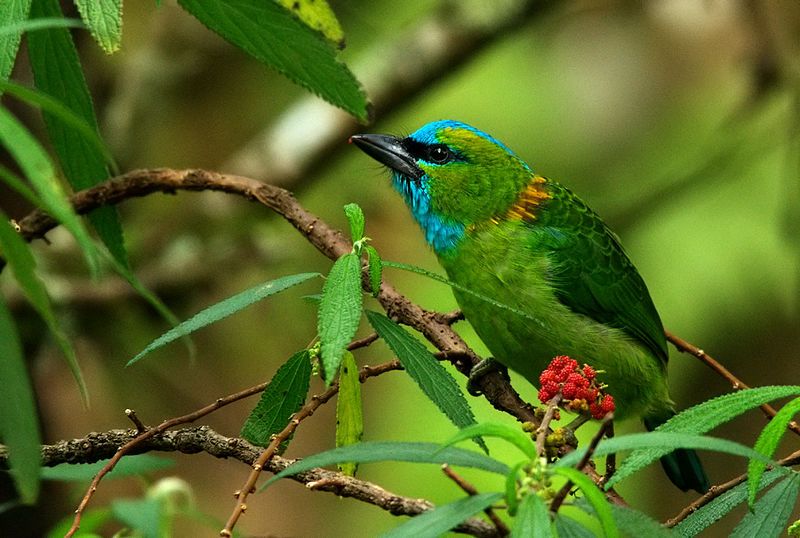
The golden-naped barbet is a unique bird species found only in Indonesia and Malaysia. It is a member of the family Megalaimidae, a group of birds found in the tropical and subtropical regions of Africa, Asia, and the Pacific Islands.
The golden-naped barbet is endemic to the island of Borneo, meaning that it is only found in that area. The habitat of the golden-naped barbet is mainly moist lowland and montane forests.
The moist lowland forests are typically found at lower elevations, while the moist montane forests are located at higher elevations. Both of these ecosystems are rich with vegetation and provide the golden-naped barbet with plenty of shelter and food.
The forests also offer a variety of different habitats that the barbet can choose from when nesting. The golden-naped barbet is an important species for its local ecosystem. It helps to disperse seeds and pollinate flowers, which aids in the regeneration of the forest.
Additionally, the golden-naped barbet plays an important role in the food chain, providing food for other animals and birds. As a result, it is important to protect the golden-naped barbet and its habitats in order to maintain the balance of the ecosystem.
| Kingdom | Animalia |
| Phylum | Chordata |
| Class | Aves |
| Order | Piciformes |
| Family | Megalaimidae |
| Genus | Psilopogon |
| Species | P. pulcherrimus |
14. Blue-Banded Pitta
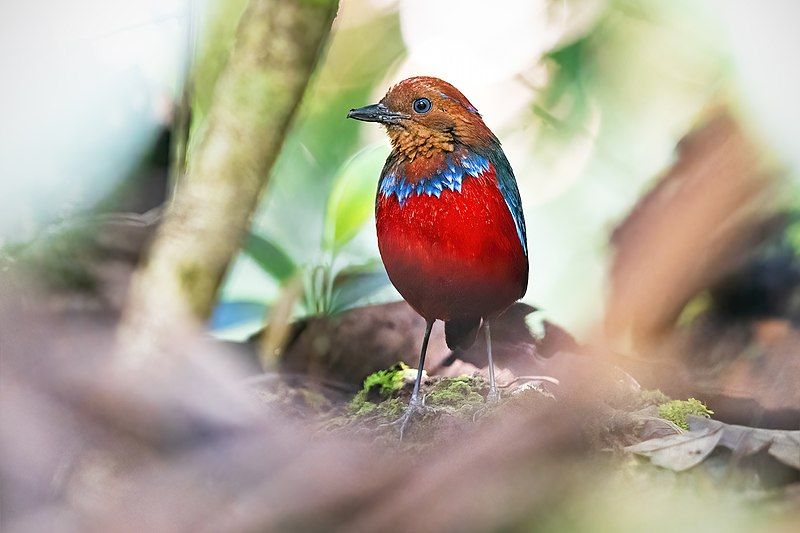
The blue-banded pitta is a type of bird belonging to the Pittidae family. It is only found on the island of Borneo, located in Southeast Asia, which is shared by three countries: Malaysia, Brunei and Indonesia.
This species of bird prefers to live in subtropical or tropical moist lowland forests. The environment is lush with abundant vegetation, making it the perfect habitat for the blue-banded pitta.
In these forests, the bird can find plenty of insects and other food sources to sustain itself. Furthermore, the dense vegetation provides shelter and protection from predators. This species of bird is a unique and special inhabitant of Borneo and these three countries.
| Kingdom | Animalia |
| Phylum | Chordata |
| Class | Aves |
| Order | Passeriformes |
| Family | Pittidae |
| Genus | Erythropitta |
| Species | E. arquata |
15. Glossy Swiftlet
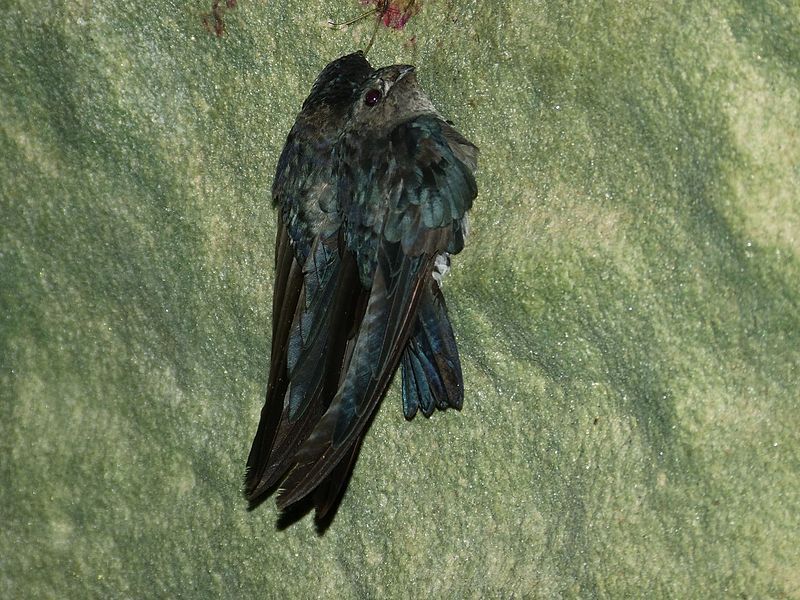
The glossy swiftlet is a species of swift belonging to the Apodidae family. It is found predominantly across the Indonesian island of Sulawesi and extends eastwards to New Guinea, the Bismarck Archipelago, and the Solomon Islands.
This species of swift is known for its unique glossy sheen that helps it blend in and camouflage with its environment. In terms of physical characteristics, the glossy swiftlet is small in size.
It has a wingspan of roughly eight to nine inches and a body length of around four inches. It is typically a brownish-gray color with a white belly and tail. It also has a forked tail and long wings that help it maneuver through the air with ease.
When it comes to its diet, the glossy swiftlet feeds on small insects such as flies and moths. It catches these insects in midair while flying, making it a highly efficient hunter.
It usually forages in groups, which helps it to maximize the amount of food it can find in a given area. The glossy swiftlet is also known for its unique nesting habits. It typically builds its nests on the walls and ceilings of caves and other sheltered areas.
The nests are made from strands of saliva that the birds secrete and weave together. These saliva nests are also used for roosting and breeding purposes. Overall, the glossy swiftlet is a fascinating species of swift.
Its unique glossy sheen, small size, and efficient hunting habits make it an interesting bird to watch and study. Furthermore, its behavior in terms of nesting and roosting is quite unique, making it a great example of nature’s creativity.
| Kingdom | Animalia |
| Phylum | Chordata |
| Class | Aves |
| Clade | Strisores |
| Order | Apodiformes |
| Family | Apodidae |
| Genus | Collocalia |
| Species | C. esculenta |
16. Bulwer’s Pheasant
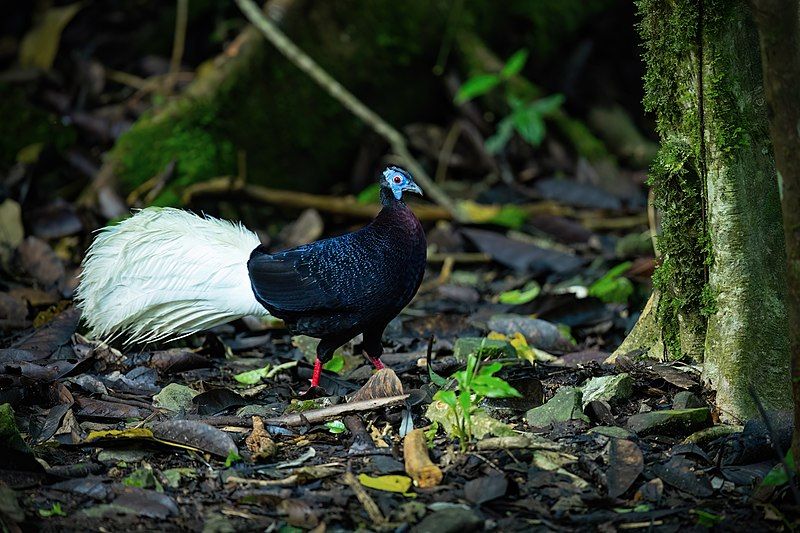
Bulwer’s pheasant, also known as Bulwer’s wattled pheasant, the wattled pheasant or the white-tailed wattled pheasant, is an endangered bird species that is endemic to the forests of Borneo.
It is a part of the family Phasianidae, which includes a variety of species that are found throughout Southeast Asia and other parts of the world. The Bulwer’s pheasant is a medium-sized bird with white tail feathers and wattled neck feathers.
It has a short tail and a long crest, which can be seen when the bird is in flight.
Its plumage is generally brown and gray, with black and white stripes on its wings. The Bulwer’s pheasant is currently listed as Vulnerable by the International Union for Conservation of Nature (IUCN).
This means that its population is in decline due to a variety of factors, including habitat destruction, hunting, and the introduction of non-native species. As such, conservation efforts are being made to protect this species from further decline.
These efforts include the establishment of protected areas, the implementation of habitat management initiatives, and the promotion of sustainable hunting practices.
Additionally, captive breeding programs are being employed in order to increase the population of the Bulwer’s pheasant. The Bulwer’s pheasant is an important species in the forests of Borneo, as it plays an important role in the ecosystem.
It is an important food source for other species, such as the endangered clouded leopard, and it is also a key pollinator of many plant species in the area. By protecting the Bulwer’s pheasant, we can help ensure the future of this species and the forests of Borneo.
| Kingdom | Animalia |
| Phylum | Chordata |
| Class | Aves |
| Order | Galliformes |
| Family | Phasianidae |
| Genus | Lophura |
| Species | L. bulweri |
17. Horsfield’s Bronze Cuckoo
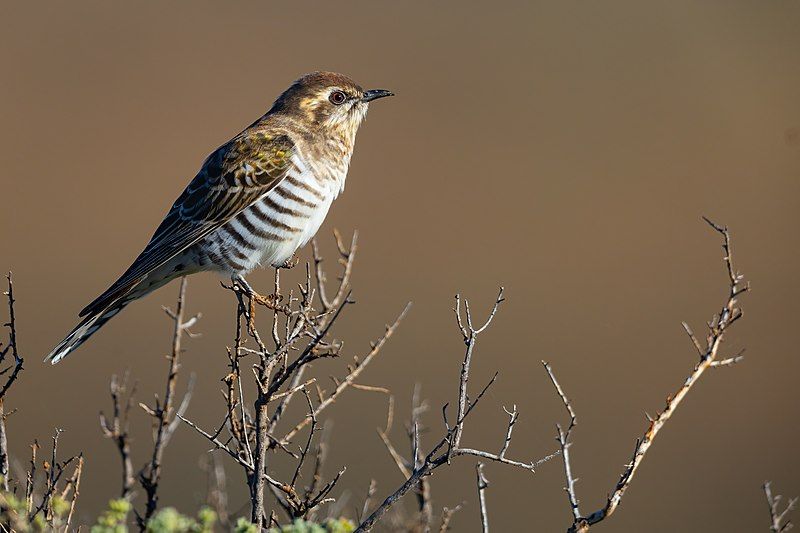
Horsfield’s bronze cuckoo is a small bird belonging to the family Cuculidae. It is one of the smallest cuckoos in the family, with the average size being 22g.
This species is unique in its appearance, with its green and bronze iridescent coloration on its back and brown barring from neck to tail. The barring is incomplete, making this species stand out from other cuckoos in the family.
The bronze cuckoo lives in forests and woodlands, where it feeds on insects and small invertebrates. It is an agile flier, using its short wings and distinctive forked tail to maneuver through dense vegetation.
The bronze cuckoo usually remains silent while in flight, but it will produce a loud and distinctive call when it lands. This call is often described as a ‘koo-koo-koo’ sound. The bronze cuckoo is a solitary bird, preferring to stay within its own territory.
This species is found throughout Southeast Asia, from Indonesia to China.
| Kingdom | Animalia |
| Phylum | Chordata |
| Class | Aves |
| Order | Cuculiformes |
| Family | Cuculidae |
| Genus | Chrysococcyx |
| Species | C. basalis |
18. Black-Naped Fruit Dove
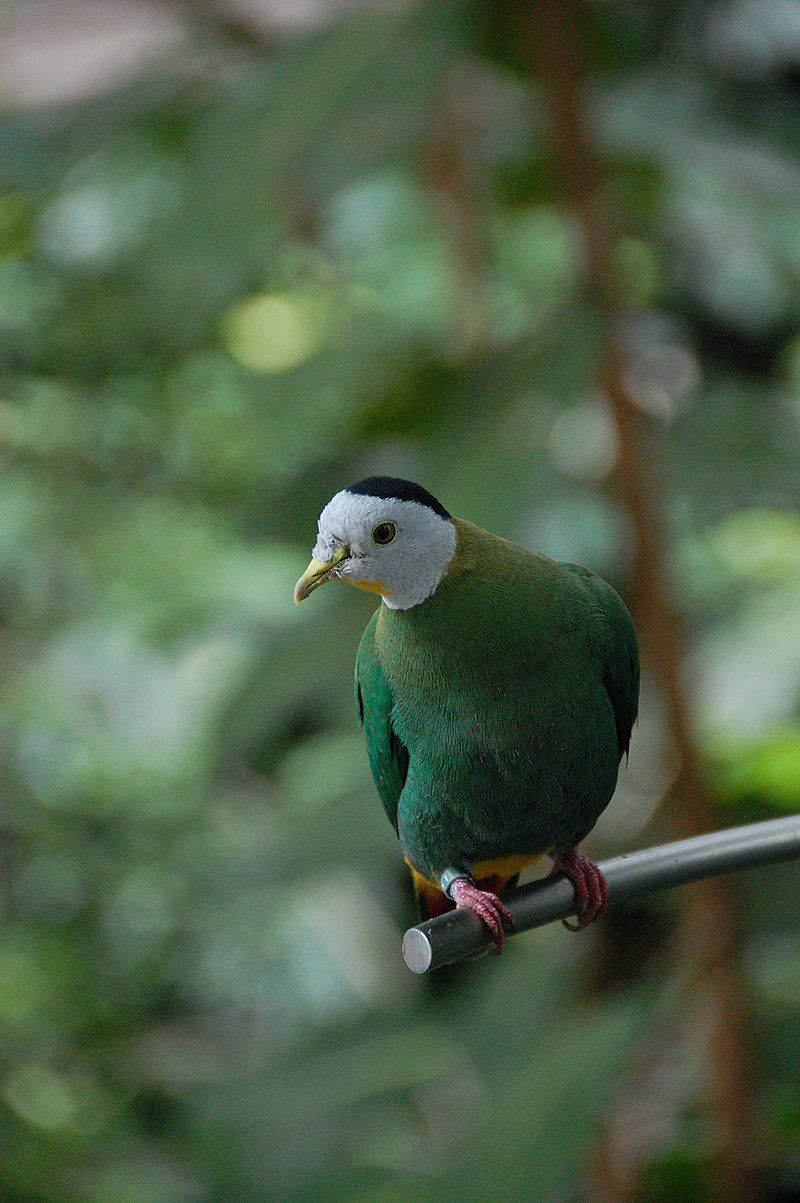
The black-naped fruit dove is a medium-sized bird, with a body measuring up to 24 cm in length. It is mostly green in color, with a yellowish bill and iris.
The male of this species is easily identified by its pale grey head and black nape, as well as its yellow throat and golden yellow and pink under tail coverts. It is also sometimes known as the black-headed fruit dove.
These features make it distinct from other fruit dove species. The black-naped fruit dove can be found in forests, woodlands, and shrublands across a wide range of habitats. It feeds on a variety of fruits, seeds, and berries.
Its diet is supplemented by nectar, insects, and other small invertebrates. The black-naped fruit dove builds a flimsy nest of twigs and leaves and usually lays two eggs.
This species is generally not considered to be threatened, although its habitat is threatened by deforestation and other human activities. As a result, the species is listed as being of least concern on the IUCN Red List.
Despite this, it is important to protect and conserve the habitats of the black-naped fruit dove for future generations.
| Kingdom | Animalia |
| Phylum | Chordata |
| Class | Aves |
| Order | Columbiformes |
| Family | Columbidae |
| Genus | Ptilinopus |
| Species | P. melanospilus |
19. Little Cuckoo-Dove
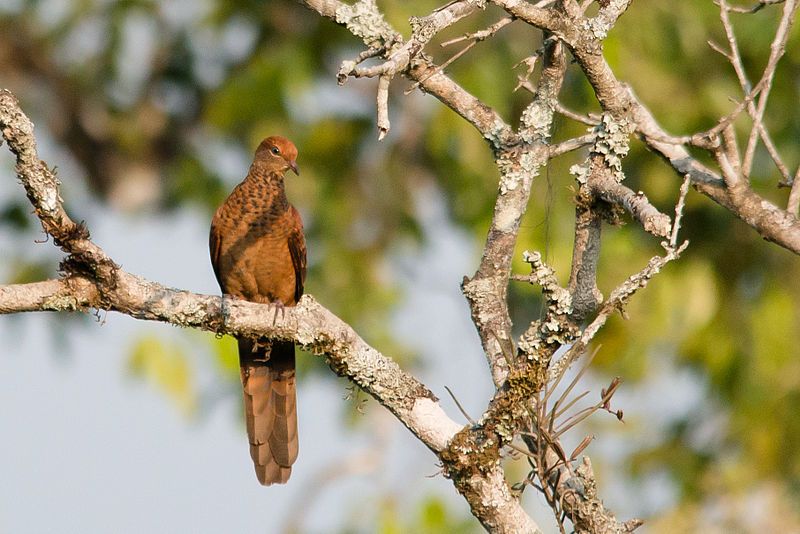
The little cuckoo-dove is a species of bird belonging to the family Columbidae, which includes pigeons and doves. It is a reddish brown bird and is found in various parts of Asia, including Brunei, China, Indonesia, Laos, Malaysia, Myanmar, Thailand, and Vietnam.
The International Union for Conservation of Nature (IUCN) has assessed the little cuckoo-dove as “Least Concern” on its Red List of Endangered Species.
This indicates that the species is not immediately threatened by extinction, although it may still be subject to localized threats. Its population is generally stable, and it is not considered to be at risk of becoming endangered in the near future.
| Kingdom | Animalia |
| Phylum | Chordata |
| Class | Aves |
| Order | Columbiformes |
| Family | Columbidae |
| Genus | Macropygia |
| Species | M. ruficeps |
20. Emerald Dove
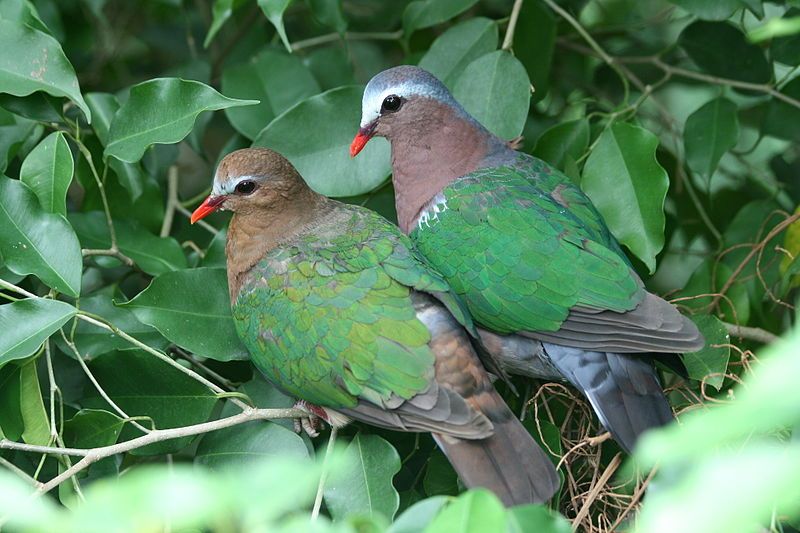
The emerald dove, also known as the common emerald dove, Asian emerald dove and grey-capped emerald dove, is a species of pigeon found in tropical and subtropical areas of the Indian Subcontinent and Southeast Asia.
It is known for its distinctive green plumage, which is the source of its various common names. The emerald dove is a widespread resident bird, meaning that it is found in numerous locations throughout its range and is not a migratory species.
It breeds in these areas and is commonly seen in gardens, parks, woodlands, and agricultural fields. The emerald dove has an unmistakable appearance, with its bright green body and wings, grey head and neck, and red legs and feet.
It has a long tail, tipped with white, and a black band across the wings. It is a relatively small bird, only measuring around 28 cm in length. The emerald dove feeds mainly on a variety of seeds, grains, and fruits, as well as the occasional insect.
It is a sociable bird, often found in small groups, and is known to form long-term pair bonds. It is not considered to be threatened and is not currently listed as endangered.
| Kingdom | Animalia |
| Phylum | Chordata |
| Class | Aves |
| Order | Columbiformes |
| Family | Columbidae |
| Genus | Chalcophaps |
| Species | C. indica |
21. Large-Tailed Nightjar
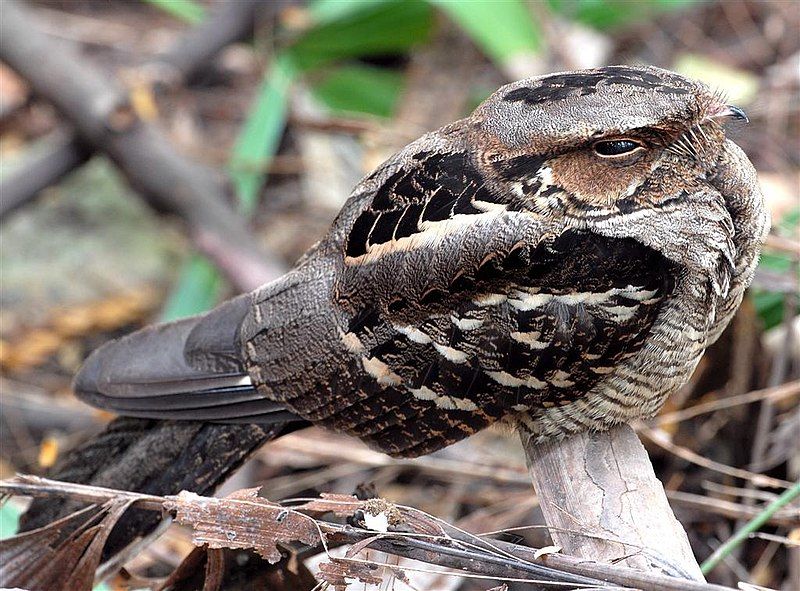
The large-tailed nightjar is a species of bird found in the family Caprimulgidae. It is native to many parts of the world and can be found in the southern Himalayan foothills, eastern South Asia, Southeast Asia, and northern Australia.
This species is characterized by its large tail, which is usually longer than its body. They are also known for their nocturnal habits, rarely seen during the day.
Large-tailed nightjars are unique birds, with many unique characteristics that set them apart from other species of nightjars.
They have large, dark eyes that help them to see in the dark and a wide, rounded wingspan that helps them to fly silently during their nocturnal activities. They also have a distinctive call, which is a trill made up of two-note phrases.
They are solitary birds, rarely seen in groups. Large-tailed nightjars feed on a variety of insects, such as moths, beetles, and other flying insects, which they catch in mid-air. They also eat small frogs and lizards.
They are adapted to their environment and have a unique camouflage coloration that helps them to blend in with their surroundings. The large-tailed nightjar is an important species in its local ecosystems, playing an important role in controlling insect populations.
They are also an important species for birdwatchers, as they provide an opportunity to observe a unique and elusive bird.
| Kingdom | Animalia |
| Phylum | Chordata |
| Class | Aves |
| Clade | Strisores |
| Order | Caprimulgiformes |
| Family | Caprimulgidae |
| Genus | Caprimulgus |
| Species | C. macrurus |
22. Spotted Dove
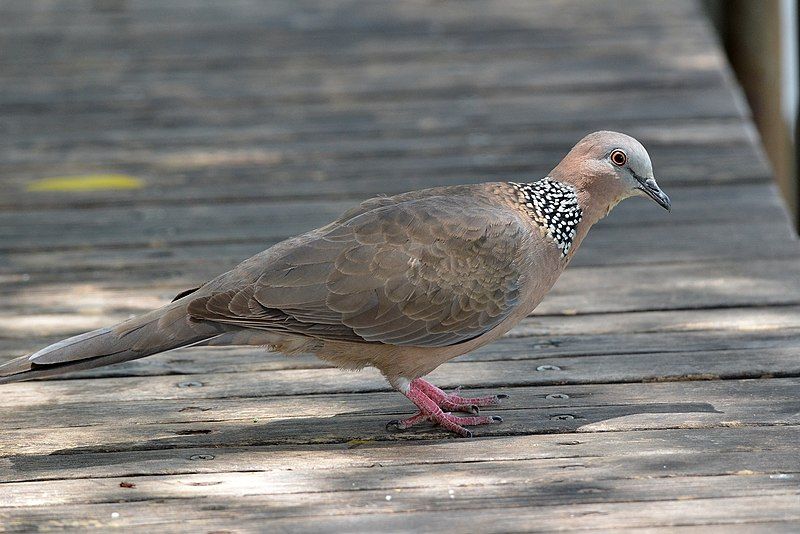
The spotted dove is a small bird with a long tail that is native to the Indian subcontinent and some parts of Southeast Asia. It is a common breeding bird in these regions and has also been introduced to many other parts of the world.
As a result, there are now feral populations of the species living in those areas. The spotted dove is a member of the pigeon family and is typically found in open forests, scrublands, and towns in its native and introduced ranges.
It feeds mainly on seeds and fruit and is often seen visiting bird feeders. The spotted dove is a relatively small species, measuring between 28 and 30 centimeters in length, and its wingspan typically ranges between 40 and 45 centimeters.
Its plumage is grey-brown with white spots and its tail is long and pointed.
| Kingdom | Animalia |
| Phylum | Chordata |
| Class | Aves |
| Order | Columbiformes |
| Family | Columbidae |
| Genus | Spilopelia |
| Species | S. chinensis |
23. Cotton Pygmy Goose
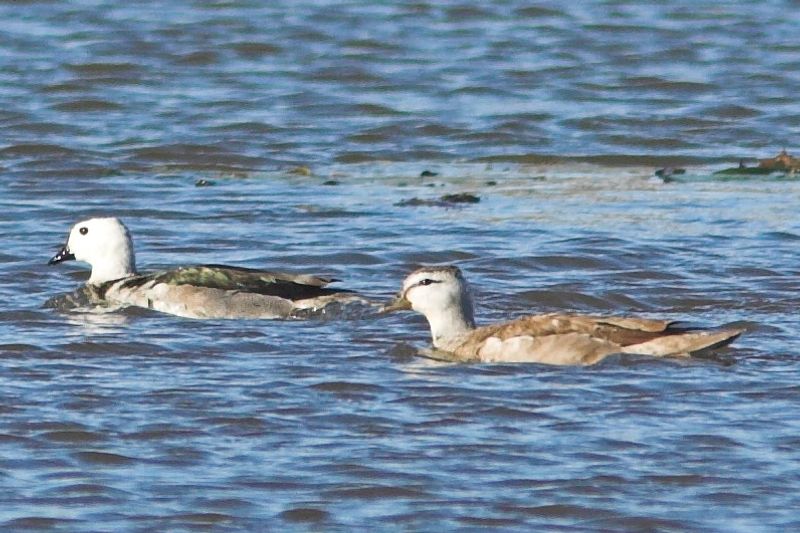
The Cotton Pygmy Goose, also known as the Cotton Teal, is a species of small perching duck that is found in many parts of Asia, including Southeast Asia.
Its range extends south and eastwards to Queensland, Australia, where they are known by the local name of White-Quilled Pygmy Goose. The Cotton Pygmy Goose is a relatively small species of duck, measuring only around 25 centimeters in length.
It is easily distinguished from other species of ducks by its white quill feathers, which are unique to this species. The Cotton Pygmy Goose is an omnivore, and its diet mainly consists of aquatic vegetation, insects, and small fish.
They are also known to feed on fallen grains and grasses. The Cotton Pygmy Goose prefers to nest in shallow water, near the edges of wetlands. They typically lay between eight to twelve eggs, and the eggs are incubated by both the male and female.
The young Cotton Pygmy Geese can fly within a few weeks of hatching, although they remain dependent on their parents for some time. The Cotton Pygmy Goose is a popular game bird and is hunted in many parts of its range. It is also kept as a pet in some parts of the world.
| Kingdom | Animalia |
| Phylum | Chordata |
| Class | Aves |
| Order | Anseriformes |
| Family | Anatidae |
| Genus | Nettapus |
| Species | N. coromandelianus |
24. Black-and-Red Broadbill
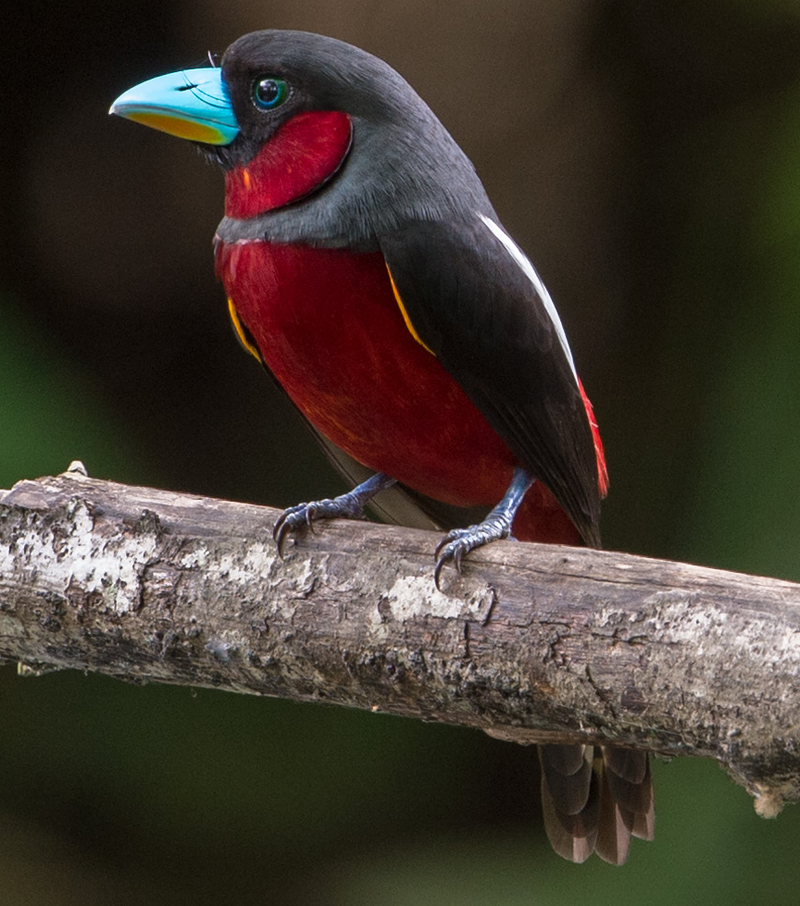
The black-and-red broadbill is an exotic species of bird native to the Eurylaimidae family. It is the only known species of the genus Cymbirhynchus, making it quite unique. This large bird is easily recognizable due to its distinct appearance.
Its underparts have a deep maroon color, while its upperparts are black. Additionally, it has a maroon neckband that stands out against its otherwise dark features. Its wings are also adorned with white stripes, furthering its impressive appearance.
In short, the black-and-red broadbill is an exquisite species of bird with a remarkable look.
| Kingdom | Animalia |
| Phylum | Chordata |
| Class | Aves |
| Order | Passeriformes |
| Family | Eurylaimidae |
| Genus | Cymbirhynchus |
| Species | C. macrorhynchos |
Conclusion
Central Kalimantan is home to a wide variety of bird species, both endemic and migratory. The diversity of bird species found in Central Kalimantan makes it a great place for birdwatchers to visit and explore.
With the right protection and conservation efforts, Central Kalimantan can continue to be an important bird habitat for generations to come.